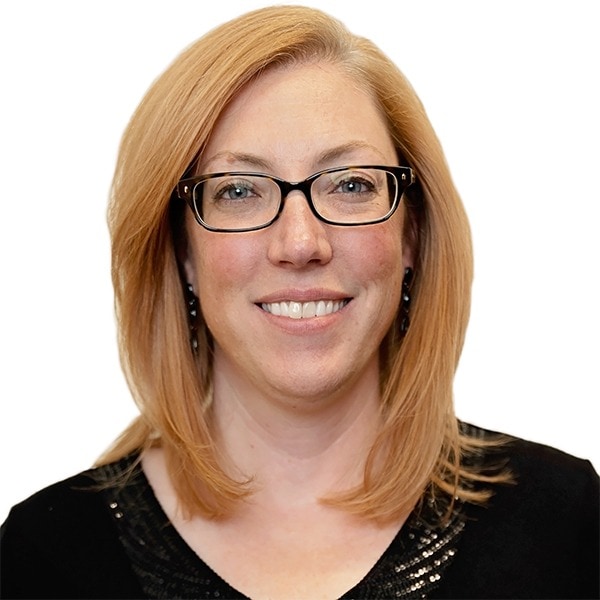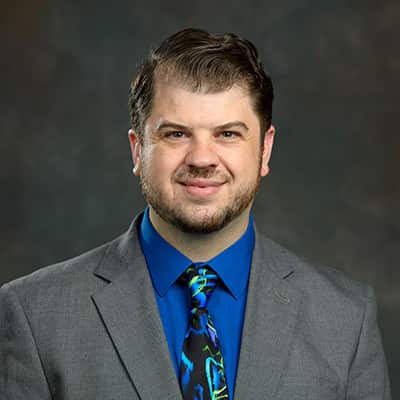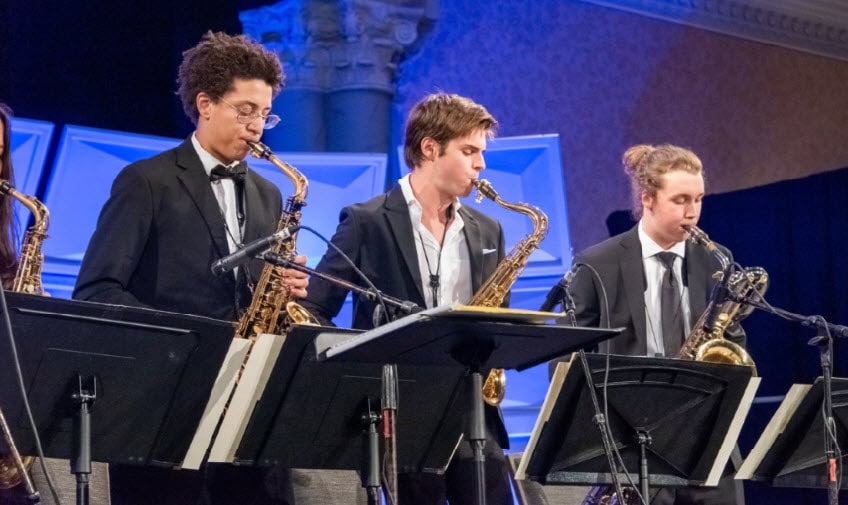/ News Posts / Tips and Techniques for Student-Centered Learning
Sharing the Baton
Tips and Techniques for Student-Centered Learning
By NAfME Members Laura Kitchel and Aaron T. Wacker
Laura Kitchel and Aaron T. Wacker presented on “Sharing the Baton: Student-Centered Tips and Techniques” during the NAfME 2021 PreK–12 Learning Collaborative in February 2021.
When was the last time you allowed your students to have a voice in the rehearsal room? A voice that helped guide the rehearsal process and led to a deep understanding of music? Student-centered approaches can empower students to take ownership over their own learning instead of waiting for all knowledge to come from the director. It also gives different voices, experiences, and knowledge a place in the learning process and engages students in self-reflection, creativity, and critical thinking.
Signs of Director-Centered Rehearsals
There are several reasons why directors are reluctant to use student-centered practices. Some like to have a captive audience from their students, while others feel the facilitator role diminishes their importance in the learning process. Others like having control over all parts of the learning process, and some feel it complicates the teacher-student relationship and power dynamics (Weimer, 2013). If you have been refraining from using student-centered practices in your ensemble rehearsals, ask yourself the following:
- Is there a lack of student participation and ownership over knowledge?
- Do I ask for students’ opinions or thoughts, but wait for the correct answer?
- Do our performances demonstrate my musical knowledge and score preparation over student growth and understanding?
If you answered yes to any of these, you may be engaging a mostly director-centered rehearsal style.
What Is Student-Centered Learning?
A student-centered learning approach ensures that all voices, experiences, and knowledge are valued and have a place in the rehearsal process, while giving room for students to grow and learn through exploration.
Student-centered learning might include student choice in:
- Curriculum (what to study or perform)
- Pedagogy (how the class is taught)
- Assessments (what and how things are graded)
- Policies (class rules and environment)
Principles of Student-Centered Learning
As Robert Duke said in his book Intelligent Music Teaching, “student learning is not a result of what teachers say, but a result of what teachers have students do” (Duke, 2005, p. 102). This is when the impact of effective teaching is most evident. When students are at the center of their own education, they will be able to continue lifelong music learning, even when there is not a teacher in front of them. A director leading a student-centered ensemble rehearsal will use the five principles of student-centered learning:
- Students participate in more of the learning tasks.
- Teachers do less speaking so that students can do more discovering.
- Teachers are more intentional about instructional design work.
- Teachers encourage students to learn from and with each other.
- Teachers and students work together to create a climate for learning.
Tips for Creating a Student-Centered Classroom
Even if directors feel rehearsals are going well, “teachers tend to perceive the classroom environments more positively than their students” (Weimer, 2013, p. 148). Directors need to build classrooms that involve students from the beginning, include a diversity of ideas and viewpoints, and provide students with structure without being over-directive. Here are five tips for creating a student-centered classroom.
- Listen to and respect each learner’s point of view.
- Include learning activities that are personally relevant to learners.
- Give learners increasing responsibility for the learning process.
- Include peer learning and peer teaching as part of the instructional method.
- Help learners work through difficulties by asking open-ended questions to help them arrive at conclusions or solutions that are satisfactory to them.
Setting up a Student-Centered Learning Environment
If a classroom environment is one of fear or judgment, students will withhold their ideas and be afraid to try new techniques. Instead, create a place where students are encouraged to explore ideas and fail freely as part of the learning process. To create an environment suited for optimal student-centered learning:
- Provide more opportunities for students to participate.
- Cultivate student relationships and teamwork.
- Experiment with new activities and teaching techniques.
- Allow students to make decisions and treat them according to their individual learning needs.
- Make failure a regular part of the learning process.
Conclusion
As you create student-centered rehearsals and become more of the “guide on the side” instead of the “sage on the stage,” remember that the goal is to “guide,” not disappear. Successful student-centered directors do not completely turn over the rehearsal to the students but help facilitate discussions that allow them to create their own best policies and procedures. Choosing a student-centered approach is an important way to keep students engaged in the course, passionate about the content, and committed to learning.
References
Duke, R. A. (2005). Intelligent music teaching: Essays on the core principles of effective instruction. Learning and Behavior Resources.
Weimer, M. (2013). Learner-centered teaching: Five key changes to practice. John Wiley & Sons.
About the authors:
 NAfME member Dr. Laura Kitchel is the Area Head of Music Education and Assistant Professor of Music at Capital University Conservatory of Music where she teaches courses in Music Education, conducts the SSA group Cantabile, and oversees and teaches in the Master of Music in Music Education summer program. Previously, she taught high school choir and general music in Kentucky, Missouri, and Ohio.
NAfME member Dr. Laura Kitchel is the Area Head of Music Education and Assistant Professor of Music at Capital University Conservatory of Music where she teaches courses in Music Education, conducts the SSA group Cantabile, and oversees and teaches in the Master of Music in Music Education summer program. Previously, she taught high school choir and general music in Kentucky, Missouri, and Ohio.
As a clinician and researcher, Dr. Kitchel has presented at many state and national conferences, including Ohio Music Education Association (2020), the National NAfME in Orlando, Florida (2019) and NAfME PreK–12 Learning Collaborative virtual conference (2021), Music Research and Teacher Education National in Atlanta, Georgia (2018), and Missouri Music Education Association (2017).
Dr. Kitchel holds a bachelor’s degree in music education from Bowling Green State University and a master’s degree in choral conducting from the University of Kentucky and her doctorate in Music Education from the University of Missouri.
 NAfME member Aaron T. Wacker (BME, University of Northern Colorado, MME, University of Northern Colorado, PhD, University of Missouri-Columbia) is Assistant Professor of Music Education and Coordinator of Music Education at The University of Tulsa. At TU, he teaches courses in music education, supervises student teachers, co-conducts the Symphonic Winds ensemble, coaches brass quintets, and teaches tuba and euphonium lessons. During the summers, Dr. Wacker teaches graduate music education courses at Capital University in Bexley, Ohio. Previously, he was an Assistant Professor of Instrumental Music at Missouri Valley College in Marshal, Missouri, and taught secondary music ensembles and general elementary music in Colorado and Missouri.
NAfME member Aaron T. Wacker (BME, University of Northern Colorado, MME, University of Northern Colorado, PhD, University of Missouri-Columbia) is Assistant Professor of Music Education and Coordinator of Music Education at The University of Tulsa. At TU, he teaches courses in music education, supervises student teachers, co-conducts the Symphonic Winds ensemble, coaches brass quintets, and teaches tuba and euphonium lessons. During the summers, Dr. Wacker teaches graduate music education courses at Capital University in Bexley, Ohio. Previously, he was an Assistant Professor of Instrumental Music at Missouri Valley College in Marshal, Missouri, and taught secondary music ensembles and general elementary music in Colorado and Missouri.
As an active music education researcher, Dr. Wacker has presented at state, national, and international conferences including the Missouri Music Education Association annual conference (2016, 2017, 2018, & 2020), Oklahoma Association of Colleges for Teacher Education (2019 & 2020), the International Society for Music Education conference (2018), Visions of Research in Music Education international conference (2019), and the Music Research and Teacher Education National Conference (2016, 2018, & 2021). He is published in the International Journal of Music Education, Journal of Band Research, Visions of Research in Music Education, Missouri Journal of Research in Music Education, Contributions to Music Education, Band and Orchestra Magazine, and The Colorado Music Educator.
Did this blog spur new ideas for your music program? Share them on Amplify! Interested in reprinting this article? Please review the reprint guidelines.
The National Association for Music Education (NAfME) provides a number of forums for the sharing of information and opinion, including blogs and postings on our website, articles and columns in our magazines and journals, and postings to our Amplify member portal. Unless specifically noted, the views expressed in these media do not necessarily represent the policy or views of the Association, its officers, or its employees.
June 7, 2021. © National Association for Music Education (NAfME.org)
Published Date
June 7, 2021
Category
- Classroom Management
- Ensembles
Copyright
June 7, 2021. © National Association for Music Education (NAfME.org)






